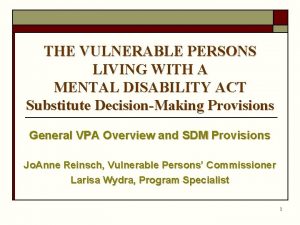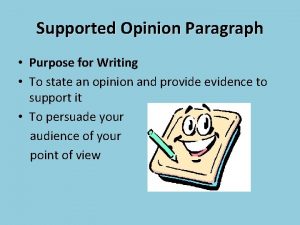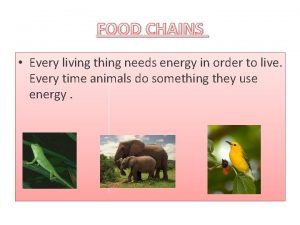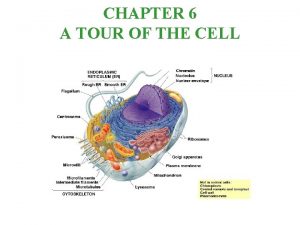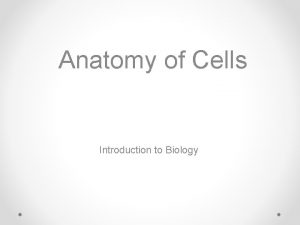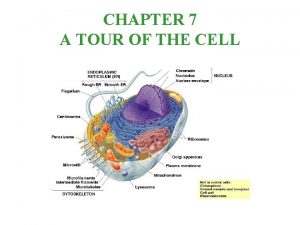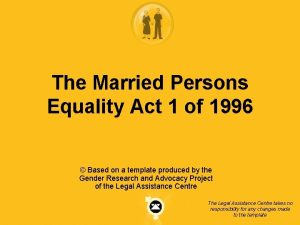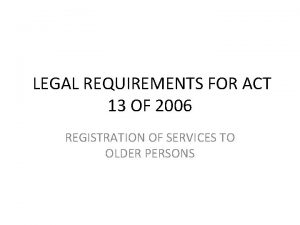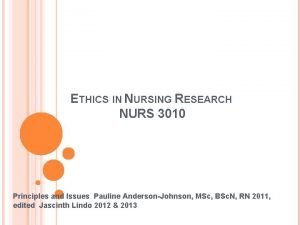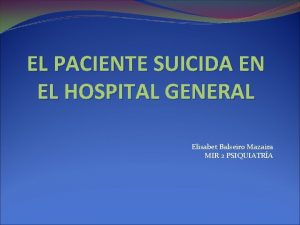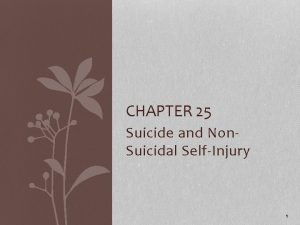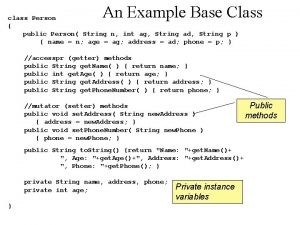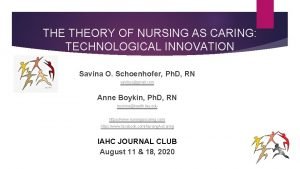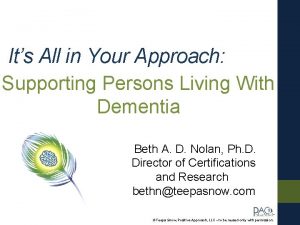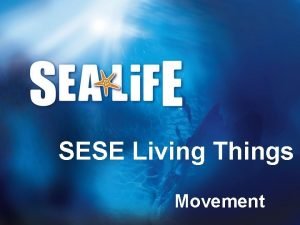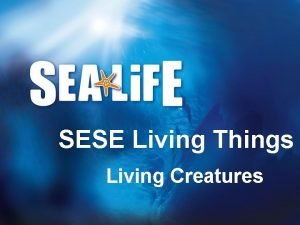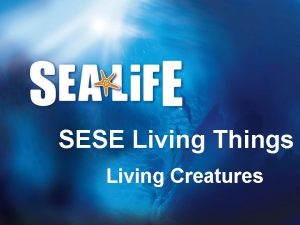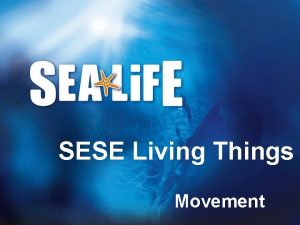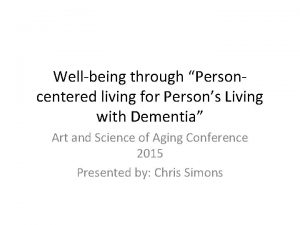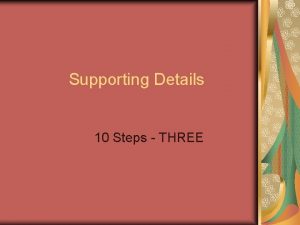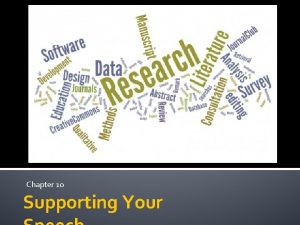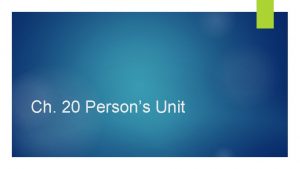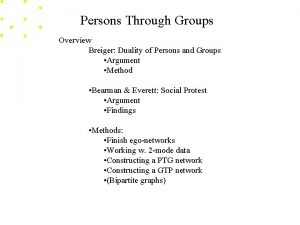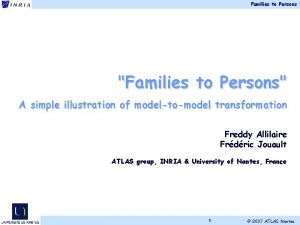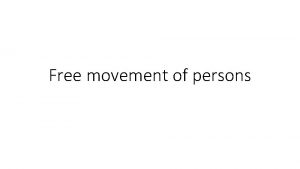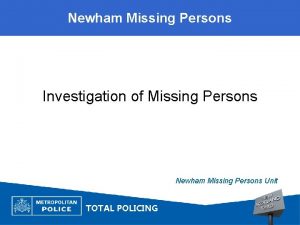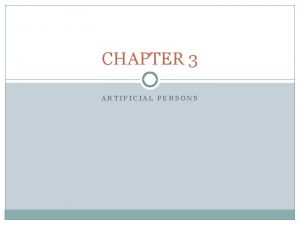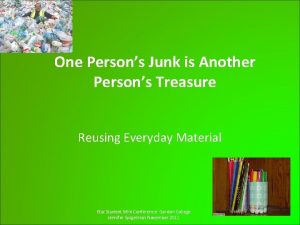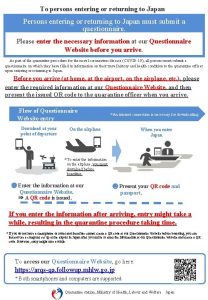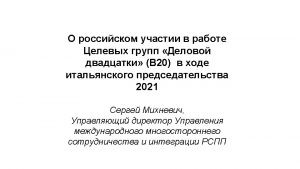Its All in Your Approach Supporting Persons Living































- Slides: 31

It’s All in Your Approach: Supporting Persons Living With Dementia Beth A. D. Nolan, Ph. D. Director of Certifications and Research bethn@teepasnow. com © Teepa Snow, Positive Approach, LLC – to be reused only with permission.

Speaker Disclosures Beth Nolan is the Director of Certifications and Research for Positive Approach® LLC © Teepa Snow, Positive Approach, LLC – to be reused only with permission.

Objectives: 1. Understanding the changes in the brain with dementia: - Impact of the amygdala on us, and those living with dementia, on family, on staff 2. Demonstrate care partnering skills of Visual -Verbal-Touch, and the Positive Physical Approach™ 3. Describe the use of Hand-under-Hand™ to guide and assist © Teepa Snow, Positive Approach, LLC – to be reused only with permission.

It Takes TWO to Tango … or Tangle… - The relationship is MOST critical NOT the outcome of one encounter - Being ‘right’ doesn’t necessarily translate into a good outcome © Teepa Snow, Positive Approach, LLC – to be reused only with permission.

Five Ways to Say, “I Am Sorry!” THIS IS HARD I'm sorry, this is hard, I hate it for you THAT HAPPENED I'm sorry, it should NOT have happened INTENT I'm sorry I was trying to help EMOTION I'm sorry I made you angry INTELLECTUAL CAPACITY I'm sorry, I had not right to make you feel that way © Teepa Snow, Positive Approach, LLC – to be reused only with permission. 5

What is Dementia? Changing Attitudes through Building Awareness, Knowledge and Skill © Teepa Snow, Positive Approach, LLC – to be reused only with permission.

Brain with Alzheimers Normal Brain used with permission from The Broken Brain: Alzheimers, 1999 University of Alabama © Teepa Snow, Positive Approach, LLC – to be reused only with permission.

The person’s brain is dying © Teepa Snow, Positive LLC – to be reused only with only permission. © Teepa Snow, Approach, Positive Approach, LLC – to be reused with permission.

DEMENTIA Vascular Dementias Alzheimer’s Disease • Young Onset • Late Life Onset (Multi-infarct) • Lewy Body Dementia • Diffuse LBD • Parkinsonian type dementia Fronto. Temporal Lobe Dementias Other Dementias • Genetic syndromes • Metabolic pxs • ETOH related • Drugs/toxin exposure • White matter diseases • Mass effects • Depression(? ) or Other Mental conditions • Infections – BBB cross © Teepa Snow, Positive Approach, LLC – to be reused only with permission.

Four Truths About Dementia 1. At least 2 parts of the brain are dying • often the hippocampus(memory) is damaged early 2. It is chronic • can’t be fixed 3. It is progressive • it gets worse 4. It is terminal • eventually © Teepa Snow, Positive Approach, LLC – to be reused only with permission.

Positron Emission Tomography (PET) Alzheimer’s Disease Progression vs. Normal Brains Normal Aging Early Alzheimer’s G. G. Small, UCLA School ofof Medicine Small, UCLA School Medicine Late Alzheimer’s 18 month old child © Teepa Snow, Positive Approach, LLC – to be reused only with permission.

Executive Control Center Right Left Impulse Control Be Logical Make Choices Start-Sequence. Complete-Move On • Self Awareness • See Others’ Point of View • • © Teepa Snow, Positive Approach, LLC – to be reused only with permission.

BIG Language CHANGE Hearing Sound – Unchanged © Teepa Snow, Positive Approach, LLC – to be reused only with permission.

Amygdala Left Right DANGEROUS NEED Aroused/ Risky Want Alert/ Aware Like © Teepa Snow, Positive Approach, LLC – to be reused only with permission.

Primitive Brain is in Charge of: Survival – • Autonomic protective – fright, flight, fight + hide or seek • Pleasure seeking – meeting survival needs & finding joy Thriving – Running the Engine • Maintain vital systems (BP, BS, O 2 sat, Temp, pain) • Breathe, suck, swallow, digest, void, defecate • Circadian rhythm • Infection control Learning New and Remembering: • Information • Places (spatial orientation) • Passage of Time (temporal orientation) © Teepa Snow, Positive Approach, LLC – to be reused only with permission.

Vision Changes With each new level of vision change, there is a decrease in safety awareness. 1. Loss of Peripheral Awareness 2. Tunnel Vision 3. Binocular Vision 4. Binocular + Object Confusion (discriminating senses) BIG VISION CHANGES 5. Monocular Vision 6. Loss of Visual Regard © Teepa Snow, Positive LLC – to be reused only with only permission. © Teepa Snow, Approach, Positive Approach, LLC – to be reused with permission.

Hippocampus BIG CHANGE Learning & Memory Center • Navigation (Way finding) • Learning & memory • Spatial orientation © Teepa Snow, Positive Approach, LLC – to be reused only with permission.

3 Zones Of Human Awareness and How We take in Data Changing Attitudes through Building Awareness, Knowledge and Skill © Teepa Snow, Positive Approach, LLC – to be reused only with permission.

3 Zones of Human Awareness 1. Public Space 6 ft or more away 3 Ways to We take in Data 1. Visual What we see -for awareness 2. Personal Space 6 ft to arm’s length 2. Verbal What we hear -for conversations 3. Intimate Space Arm’s length or closer -for intense closeness 3. Touch What we touch & feel © Teepa Snow, Positive Approach, LLC – to be reused only with permission.

Positive Physical Approach™ 1. Stop moving 6 ft out 2. Greet: Hi sign (open by face), say name 3. Move hand into a handshake position 4. SLOWLY come in from the front -within visual range (or starts there) 5. Move into Supportive Stance 6. Hand shake–move into ‘Hand-under-Hand®’ 7. Move to side; Get low –sits or kneels 8. Make connection (wait for their response!) 9. Deliver a message – using V-V-T cues © Teepa Snow, Positive Approach, LLC – to be reused only with permission.

Positive Physical Approach™ 1. Stop moving 6 ft out 3. Move into a handshake 4. SLOWLY come in from front 5. Supportive Stance 6. Move into Hu. H® 8. Make connection (wait!) © Teepa Snow, Positive Approach, LLC – to be reused only with permission.

If you can’t get low, find a chair © Teepa Snow, Positive Approach, LLC – to be reused only with permission.

Hand-under-Hand™ To guide and assist ™ HUH © Teepa Snow, Positive Approach, LLC – to be reused only with permission.

Hand-under-Hand™ Assistance ✔Helps assist doing WITH, not for ✔Helps protect their: fingers, wrist, arm ✔Helps protect us: Gives you cues before a PLWD wants to strike out ✔Gives them something to squeeze/grab onto ✔Helps direct gaze – eye-hand coordination ✔Pressure in the palm is calming © Teepa Snow, Positive Approach, LLC – to be reused only with permission.

Hand-under-Hand™ Assistance Protects aging, thin, fragile, forearm skin © Teepa Snow, Positive Approach, LLC – to be reused only with permission.

High Risk © Teepa Snow, Positive Approach, LLC – to be reused only with permission.

Sensory Strip Motor Strip White Matter Connections BIG CHANGES Right Left Automatic Speech Rhythm – Music Expletives PRESERVED Formal Speech & Language Center HUGE CHANGES

Connection & Communication Positive Personal Connections Positive Action Starters © Teepa Snow, Positive Approach, LLC – to be reused only with permission.

Positive Personal Connections (PPC) 1. Greet or Meet • introduce yourself and use their preferred name • 2. “Hi ___, I am ___. ” or, “I am ___ and you are? ” Say something NICE • Indicate something about them of value 3. Be friendly • Share about you then leave a blank • 4. “I’m from Michigan, and you’re from? ” Notice something • 5. Point out something in the environment Be curious • Explore a possible unmet like, want or need © Teepa Snow, Positive Approach, LLC – to be reused only with permission.

Positive Action Starters (PAS) 1. Help – Be sure to compliment their skill in this area, then ask for help. “I could use your help…” 2. Try – Hold up or point to the item you would like to use, possibly sharing in the dislike of the item or task, “Well, let’s try this. ” 3. Choice – Try using visual cues to offer two possibilities or one choice with something else as the other option. “Coffee or Tea? ” “This? Or something else? ” 4. Short and Simple – Give only the first piece of information, “It’s about time to …” 5. Step by Step – Only give a small part of the task at first, “Lean forward…. ” © Teepa Snow, Positive Approach, LLC – to be reused only with permission.

Who has the bigger brain? YOU have the POWER to choose Thank you © Teepa Snow, Positive Approach, LLC – to be reused only with permission.
 A person's trash is another person's treasure
A person's trash is another person's treasure The vulnerable persons living with a mental disability act
The vulnerable persons living with a mental disability act Smallest living unit of life
Smallest living unit of life Name all the lines
Name all the lines Living and nonliving things venn diagram
Living and nonliving things venn diagram Is moss living or nonliving
Is moss living or nonliving Living non living dead
Living non living dead Writing opinion paragraph
Writing opinion paragraph Food chain begins with
Food chain begins with Producers in food chain
Producers in food chain Gets its energy from eating living things
Gets its energy from eating living things The cell is a living unit greater than the sum of its parts
The cell is a living unit greater than the sum of its parts Capsule flagella pili nucleoid desmosome
Capsule flagella pili nucleoid desmosome The cell is a living unit greater than the sum of its parts
The cell is a living unit greater than the sum of its parts Give us your hungry your tired your poor
Give us your hungry your tired your poor Liable to vat
Liable to vat Married persons equality act 1 of 1996
Married persons equality act 1 of 1996 The principle of respect for persons
The principle of respect for persons Missing persons montana
Missing persons montana Dq98 form
Dq98 form One god in three divine persons
One god in three divine persons The principle of respect for persons
The principle of respect for persons The principle of respect for persons
The principle of respect for persons Escala de sad persons
Escala de sad persons Some common trafficking in persons contract violations
Some common trafficking in persons contract violations Chapter 25 suicide and nonsuicidal self injury
Chapter 25 suicide and nonsuicidal self injury Class of persons examples
Class of persons examples Tidslig synsvinkel
Tidslig synsvinkel Famous persons
Famous persons Dance of caring persons
Dance of caring persons This is a person's essential
This is a person's essential Persons pivots
Persons pivots

